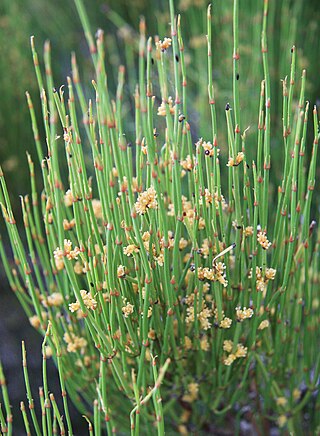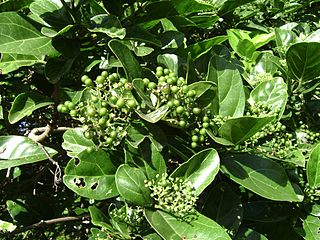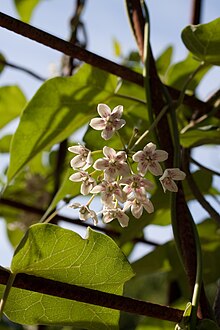
Olea is a genus of about 40 species in the family Oleaceae, native to warm temperate and tropical regions of the Middle East, southern Europe, Africa, southern Asia, and Australasia. They are evergreen trees and shrubs, with small, opposite, entire leaves. The fruit is a drupe. Leaves of Olea contain trichosclereids.

Arisaema is a large and diverse genus of the flowering plant family Araceae. The largest concentration of species is in China and Japan, with other species native to other parts of southern Asia as well as eastern and central Africa, Mexico and eastern North America. Asiatic species are often called cobra lilies, while western species are often called jack-in-the-pulpit; both names refer to the distinctive appearance of the flower, which consists of an erect central spadix rising from a spathe.

Adenophora is a genus of flowering plants in the family Campanulaceae, the bellflowers. Plants of this genus are known commonly as ladybells. Most are native to eastern Asia, with a few in Europe. Many are endemic to either China or Siberia.

Maianthemum includes the former genus Smilacina and is a genus of perennial herbaceous flowering plants with fleshy, persistent rhizomes. It is widespread across much of North America, Europe and Asia, and may be terrestrial, aquatic or epiphytic. It is characterized by simple, unbranched stems that are upright, leaning or hanging down and have 2–17 foliage leaves. Leaves are simple and may clasp the stem or be short-petiolate. The inflorescence is terminal and either a panicle or a raceme with few to many pedicelate flowers. Most species have 6 tepals and 6 stamens; a few have parts in 4s. Tepals are distinct in most species and all of similar size. Flowers are spreading, cup-shaped or bell-shaped and usually white, but lavender to red or green in some species. Fruits are rounded to lobed berries containing few to several seeds.

Paris is a genus of flowering plants described by Linnaeus in 1753. It is widespread across Europe and Asia, with a center of diversity in China.

The genus Tacca, which includes the batflowers and arrowroot, consists of flowering plants in the order Dioscoreales, native to tropical regions of South America, Africa, Australia, Southeast Asia, and various Oceanic islands. In older texts, the genus was treated in its own family Taccaceae, but the 2003 APG II system incorporates it into the family Dioscoreaceae. The APG III and APG IV systems continue to include Tacca in Dioscoreaceae.

Phoebe is a genus of evergreen trees and shrubs belonging to the Laurel family, Lauraceae. There are 75 accepted species in the genus, distributed in tropical and subtropical Asia and New Guinea. 35 species occur in China, of which 27 are endemic. The first description of the genus was of the type species P. lanceolata made in 1836 by Christian Gottfried Daniel Nees von Esenbeck in Systema Laurinarum, p. 98.

Ephedra is a genus of gymnosperm shrubs. The various species of Ephedra are widespread in many arid regions of the world, ranging across southwestern North America, southern Europe, northern Africa, southwest and central Asia, northern China and western South America. It is the only extant genus in its family, Ephedraceae, and order, Ephedrales, and one of the three living members of the division Gnetophyta alongside Gnetum and Welwitschia.

Aletris, the colicroot, colicweed, crow corn, or unicorn root, is a genus of flowering plants in the family Nartheciaceae, native to North America and to eastern and southeastern Asia, especially China. It was used as a component in Lydia Pinkham's original Vegetable Compound.

The genus Helwingia consists of shrubs or rarely small trees native to eastern Asia, the Himalayas, and northern Indochina. It is the only genus in the family Helwingiaceae.

Linnaea is a plant genus in the honeysuckle family Caprifoliaceae. Until 2013, the genus included a single species, Linnaea borealis. In 2013, on the basis of molecular phylogenetic evidence, the genus was expanded to include species formerly placed in Abelia, Diabelia, Dipelta, Kolkwitzia and Vesalea. However, this is rejected by the majority of subsequent scientific literature and flora.

Anodendron is a genus of plant in the family Apocynaceae first described as a genus in 1844. It is native to most of tropical Asia: China, the Indian subcontinent, Southeast Asia, New Guinea, and some islands of the western Pacific.

Premna is a genus of flowering plants in the mint family, Lamiaceae, first described for modern science in 1771. It is widespread through tropical and subtropical regions in Africa, southern Asia, northern Australia, and various islands in the Pacific and Indian Oceans.
- Premna acuminataR.Br. - Australia, New Guinea
- Premna acutataW.W.Sm. - southwestern China
- Premna albaH.J.Lam - Palau
- Premna ambongensisMoldenke - Madagascar
- Premna amplectensWall. ex Schauer - Thailand, Myanmar
- Premna angolensisGürke - tropical Africa
- Premna angustifloraH.J.Lam - Palau
- Premna annulataH.R.Fletcher - Thailand, Laos, Vietnam
- Premna aureolepidotaMoldenke - Madagascar
- Premna balakrishnaniiA.Rajendran & P.Daniel - Tamil Nadu
- Premna balansaeDop - Vietnam
- Premna barbataWall. ex Schauer - Indian Subcontinent, Myanmar
- Premna bengalensisC.B.Clarke - Indian Subcontinent, Myanmar, Vietnam
- Premna bequaertiiMoldenke - Uganda, Rwanda, Zaïre
- Premna bracteataWall. ex C.B.Clarke - Himalayas, Tibet, Yunnan, Nepal, Assam, Bhutan, Myanmar
- Premna cambodianaDop - Cambodia, Vietnam
- Premna cavalerieiH.Lév - China
- Premna chevalieriDop - Thailand, Laos, Vietnam, China
- Premna chrysoclada(Bojer) Gürke - Kenya, Tanzania, Guinea-Bissau
- Premna collinsaeCraib - Thailand
- Premna confinisC.Pei & S.L.Chen ex C.Y.Wu - China
- Premna congolensisMoldenke - Zaïre, Angola, Cabinda
- Premna cordifoliaRoxb. - Thailand, Vietnam, Malaya
- Premna coriaceaC.B.Clarke - Indian Subcontinent, Thailand, Andaman Islands
- Premna corymbosaRottler - India, Sri Lanka, Andaman & Nicobar Islands
- Premna crassaHand.-Mazz. - Vietnam, China
- Premna debianaA.Rajendran & P.Daniel - Arunachal Pradesh
- Premna decaryiMoldenke - Madagascar
- Premna decurrensH.J.Lam - Indonesia
- Premna discolorVerdc. - Kenya
- Premna dubiaCraib - Laos, Thailand, Vietnam
- Premna esculentaRoxb. - Assam, Bangladesh, Myanmar, Thailand
- Premna fohaiensisC.Pei & S.L.Chen ex C.Y.Wu - China (Yunnan)
- Premna fordiiDunn - China
- Premna fulvaCraib - Indochina, Indonesia, China
- Premna garrettiiH.R.Fletcher - Thailand
- Premna glaberrimaWight - southern India
- Premna glandulosaHand.-Mazz. - China (Yunnan)
- Premna gracillimaVerdc. - Kenya, Tanzania
- Premna grandifoliaA.D.J. Meeuse, illegitimate name, = Premna hutchinsonii
- Premna grossaWall. ex Schauer - Myanmar
- Premna guillauminiiMoldenke - New Caledonia
- Premna hainanensisChun & F.C.How - China (Hainan)
- Premna hans-joachimiiVerdc. - Tanzania
- Premna henryana(Hand.-Mazz.) C.Y.Wu - China
- Premna herbaceaRoxb. - Himalayas, Yunnan, Indian Subcontinent, Southeast Asia, Indonesia, New Guinea, northern Australia
- Premna hildebrandtiiGürke - Zaire, Kenya, Tanzania, Mozambique, Zimbabwe
- Premna hispidaBenth. - West Africa
- Premna humbertiiMoldenke - Madagascar
- Premna hutchinsoniiMoldenke - Ivory Coast
- Premna interruptaWall. ex Schauer - southern China, Himalayas, Indochina
- Premna jalpaigurianaT.K.Paul - West Bengal
- Premna khasianaC.B.Clarke - Assam, Thailand
- Premna lepidellaMoldenke - Madagascar
- Premna ligustroidesHemsl - China
- Premna longiacuminataMoldenke - Madagascar
- Premna longifoliaRoxb. - Himalayas
- Premna longipetiolataMoldenke - Madagascar
- Premna lucensA.Chev. - West Africa
- Premna macrophyllaWall. ex Schauer - Assam, Indochina
- Premna madagascariensisMoldenke - Madagascar
- Premna mariannarumSchauer - Mariana Islands
- Premna matadiensisMoldenke - Zaïre, Angola
- Premna maximaT.C.E. Fr. - Kenya
- Premna mekongensisW.W.Sm. - China (Yunnan)
- Premna micranthaSchauer - India, Assam, Bangladesh
- Premna microphyllaTurcz. - Japan, Ryukyu Islands, China
- Premna millefloraC.B.Clarke - Assam
- Premna milneiBaker - Nigeria, Bioko
- Premna minorDomin - Queensland
- Premna mollissimaRoth - Indian Subcontinent, Yunnan, Indochina, Philippines
- Premna mooiensis(H.Pearson) W.Piep - Mozambique, Eswatini, South Africa
- Premna mortehaniiDe Wild - Zaïre
- Premna mundanthuraiensisA.Rajendran & P.Daniel - Tamil Nadu
- Premna neurophyllaChiov. - Ethiopia
- Premna oblongataMiq. - Indonesia, Philippines
- Premna odorataBlanco - - Indian Subcontinent, Yunnan, Southeast Asia, New Guinea, northern Australia; naturalized in Miami-Dade County in Florida
- Premna oliganthaC.Y.Wu - China
- Premna oligotrichaBaker - Ethiopia, Somalia, Kenya, Tanzania
- Premna orangeanaCapuron - Madagascar
- Premna paisehensisC.Pei & S.L.Chen - China (Guangxi)
- Premna pallescensRidl.- Borneo, Indonesia
- Premna parasiticaBlume - Indonesia
- Premna parvilimbaC.Pei - China (Yunnan)
- Premna paucinervis(C.B.Clarke) Gamble - Kerala, Tamil Nadu
- Premna paulobarbataH.J.Lam - Mariana Islands
- Premna perplexansMoldenke - Madagascar
- Premna perrieriMoldenke - Madagascar
- Premna pinguisC.B.Clarke - Assam, Bangladesh, Myanmar, Java
- Premna politaHiern - Angola
- Premna procumbensMoon - India, Bangladesh, Sri Lanka
- Premna protrusaA.C.Sm. & S.Darwin - Fiji
- Premna puberulaPamp. - China
- Premna pubescensBlume - Indonesia, Philippines, Christmas Island
- Premna puerensisY.Y.Qian - China (Yunnan)
- Premna punduanaWall. ex Schauer - Arunachal Pradesh, Assam, Bangladesh
- Premna puniceaC.Y.Wu - China (Yunnan)
- Premna purpurascensThwaites - Sri Lanka
- Premna quadrifoliaSchumach. & Thonn. - West Africa
- Premna rabakensisMoldenke - Cambodia
- Premna regularisH.J.Lam - Philippines, Indonesia, New Guinea
- Premna repensH.R.Fletcher - Thailand
- Premna resinosa(Hochst.) Schauer - East Africa, Arabian Peninsula, India
- Premna richardsiaeMoldenke - Tanzania
- Premna rubroglandulosaC.Y.Wu - China (Yunnan)
- Premna scandensRoxb. - China (Yunnan), Himalayas, Andaman Island, Indochina
- Premna schimperiEngl - East Africa
- Premna schliebeniiWerderm. - Tanzania, Mozambique
- Premna scoriarumW.W.Sm. - Tibet, Yunnan, Myanmar
- Premna senensisKlotzsch - eastern + central Africa
- Premna serrataH.R.Fletcher - Thailand
- Premna serratifoliaL. - widespread in East Africa, the Indian Subcontinent, Southeast Asia, northern Australia, islands of Pacific + Indian Oceans
- Premna siamensisH.R.Fletcher - Thailand
- Premna stenobotrysMerr. - Vietnam
- Premna steppicolaHand.-Mazz. - China
- †Premna sterculiifoliaKing & Gamble - Malaya but extinct
- Premna straminicaulisC.Y.Wu - China (Yunnan)
- Premna subcapitataRehder - China
- Premna sulphurea(Baker) Gürke - Angola
- Premna sunyiensisC.Pei - China (Guangdong)
- Premna szemaoensisPei - China (Yunnan)
- Premna tahitensisJ.Schauer - many islands of the Pacific
- Premna tanganyikensisMoldenke - Tanzania, Mozambique
- Premna tapintzeanaDop - China (Yunnan)
- Premna teniiC.Pei - China (Yunnan)
- Premna thoreliiDop - Laos
- Premna thwaitesiiC.B.Clarke - Sri Lanka
- Premna tomentosaWilld. - Indian Subcontinent, Southeast Asia, Queensland, Solomon Islands
- Premna trichostomaMiq. - Southeast Asia, Indonesia, New Guinea
- Premna urticifoliaRehder - China (Yunnan)
- Premna velutinaGürke - Burundi, Kenya, Tanzania, Mozambique
- Premna venulosaMoldenke - Madagascar
- Premna wightianaSchauer - India, Sri Lanka
- Premna wuiBoufford & B.M.Barthol. - China (Yunnan)
- Premna yunnanensisW.W.Sm - China

Kobresia is a genus of plants in the sedge family. They are sometimes called bog sedges. These perennial sedges are quite similar to Carex species in appearance. The genus is widespread across much of Europe, Asia and North America, with many species native to the Himalayas.

Sauromatum is a genus of flowering plants in the family Araceae. The genus is native to tropical Africa, tropical Asia, and the Arabian Peninsula. Their inflorescences last for only a few hours to a day and give off an unpleasant smell. The inflorescence disperses its odor by heating up.
- Sauromatum brevipes(Hook.f.) N.E.Br. - Tibet, Nepal, Bhutan, Assam
- Sauromatum brevipilosum(Hett. & Sizemore) Cusimano & Hett. - Sumatra
- Sauromatum diversifolium(Wall. ex Schott) Cusimano & Hett. - eastern Himalayas, Tibet, Sichuan, Yunnan, Nepal, Bhutan, Assam, Myanmar, Cambodia
- Sauromatum gaoligongenseJ.C.Wang & H.Li - Yunnan
- Sauromatum giganteum(Engl.) Cusimano & Hett. - Anhui, Gansu, Hebei, Henan, Jilin, Liaoning, Shandong, Shanxi, Sichuan, Tibet
- Sauromatum hirsutum(S.Y.Hu) Cusimano & Hett. - Yunnan, Laos, Thailand, Vietnam
- Sauromatum horsfieldiiMiq. - Guangxi, Guizhou, Sichuan, Yunnan, Laos, Myanmar, Thailand, Vietnam, Sumatra, Java, Bali
- Sauromatum tentaculatum(Hett.) Cusimano & Hett. - Thailand
- Sauromatum venosum(Dryand. ex Aiton) Kunth - tropical Africa from Ethiopia south to Mozambique and west to Cameroon; Yemen, Saudi Arabia; Indian Subcontinent; Myanmar; Tibet, Yunnan

Pholidota, commonly known as rattlesnake orchids, is a genus of flowering plants from the orchid family, Orchidaceae. Plants in this genus are clump-forming epiphytes or lithophytes with pseudobulbs, each with a single large leaf and a large number of small, whitish flowers arranged in two ranks along a thin, wiry flowering stem that emerges from the top of the pseudobulb. There are about thirty five species native to areas from tropical and subtropical Asia to the southwestern Pacific.

Beaumontia is a small genus of evergreen woody vines in the milkweed family. It is native to China, the Indian subcontinent, and Southeast Asia.

Periploca is a genus of plants in the family Apocynaceae, first described for modern science by Linnaeus in 1753. It is native to Europe, Asia, and Africa.
- Periploca aphyllaDecne. - Middle East from Sinai to Pakistan
- Periploca calophylla(Wight) Falc. - S China, Nepal, Bhutan, Assam, E Himalayas, Vietnam
- Periploca chevalieriBrowicz - Cape Verde Islands
- Periploca chrysanthaD.S. Yao, X.D. Chen & J.W. Ren - Gansu Province in China
- Periploca floribundaTsiang - Yunnan, Vietnam
- Periploca forrestiiSchltr. - Guangxi, Guizhou, Qinghai, Sichuan, Tibet, Yunnan, India, Kashmir, Myanmar, Nepal
- Periploca graecaL. - Mediterranean
- Periploca hydaspidisFalc. - Kashmir
- Periploca laevigataAiton - Canary Islands, Savage Islands
- Periploca linearifoliaQuart.-Dill. & A. Rich - Ethiopia
- Periploca nigrescensAfzel. - W Africa
- Periploca refractifoliaGilli - Tanzania
- Periploca sepiumBunge - widespread across much of China
- Periploca tsiangiiD. Fang & H.Z. Ling - Guangxi Province in China
- Periploca visciformis(Vatke) K. Schum. - Somalia

Isodon (teacost) is a genus of flowering plants in the family Lamiaceae described in 1840. It is native to tropical and subtropical parts of the Old World, primarily Asia but two species are from Africa. Many of the species are endemic to China, where it is called xiangchacai or "fragrant tea".
Micrechites is a genus of flowering plants in the family Apocynaceae, first described as a genus in 1857. It is native to China, the eastern Himalayas, Southeast Asia, Papuasia, and Queensland.



















